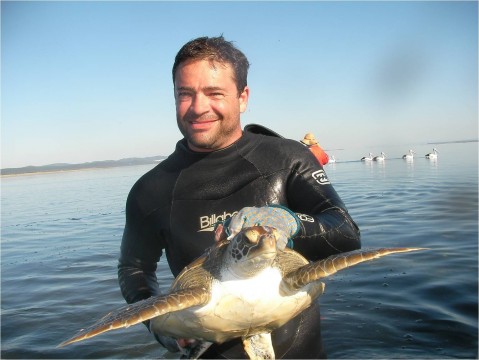On the edge
Blogger: Marine turtle researcher, Dan Godoy
Our ocean currents ferry all manner of organisms into our seas and onto our shores, and one such animal that occasionally appears in NZ waters is turtles. Marine turtles have been reported from our waters for more than 100 years, yet, there has been little written about them.
Marine turtles have been my interest of study for 6 years now, and with the data I have managed to collect I am slowly beginning to build a picture of their distribution, age-range, and threats in NZ waters. Over the past few years, I’ve collected first and second-hand information about turtle sightings and strandings, so that we can develop some science-based management around these endangered creatures. A portion of my data has come from live rescues of near-dead creatures that are found stranded or floating at sea. Once found the animal is transported immediately to Kelly Tarlton’s Aquarium. Of these individuals a large proportion of them are rehabilitated back to health. Of the ones that don’t survive or are found dead, necropsies are undertaken to gather more data.
One of the hurdles to studying these species in NZ is that they’re largely seen as occasional visitors or wayward stragglers, and do not live in our waters permanently. So, for the most part they remain largely unstudied. What I have discovered is that although green turtles don’t breed here, some may spend a part of their life cycle inhabiting our waters in the Upper North Island.
There are 5 species of marine turtle that have been found in NZ: the green, hawksbill, leatherback, olive ridley, and loggerhead. All of them are listed in the IUCN Red List of Threatened Species. http://www.iucnredlist.org/.
Generally speaking, it is the first part of a turtle’s life cycle that is the most trying – it is estimated less than 1% make it to adult hood. Once (green) turtles reach maturity at an age of 25-35 years old, it is really only humans that are their biggest threat. Human activities such as pollution and fishing are contributing to the overall decline of turtles in the Pacific. Turtles are unfortunately prone to entanglement by fishing nets and they are especially susceptible to ingesting plastic and other marine debris. For example, leatherback turtles are known to ingest plastic bags because they look very much like jelly-fish – one of their prey items. The more we learn about marine turtles in NZ the better we can understand their life cycle which will contribute to their conservation. As a result of this study and increased awareness of marine turtles in New Zealand, we will be better informed to make appropriate decisions for the management of these endangered species

